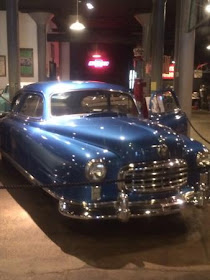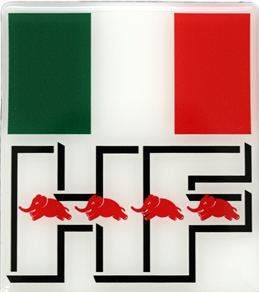Engineer and Formula Vee racer Paul Anderson wrote about a recent visit to the Wisconsin Automive Museum, and his quest to find a car this humble scribe had never heard of....

Paul needn't have worried about that quest for the unknown. His first photo (below) shows something completely unfamiliar to this writer. The 1921 Briggs and Stratton Flyer, a wooden plank buckboard with wheels and tires fit for a bicycle, seems like minimalism on a rampage except for that odd 5th wheel, which is where power (well, 2 hp anyway) is applied, thus avoiding a differential. I'm guessing the brake (there must be one, right?) applies to the 5th wheel as well, as there is no obvious sign of conventional brakes on the other four. Allegedly the cheapest car ever offered in America ($200), it parallels the spindly "cyclecars" popular in England and France in the 1920s, like the chain-drive Frazer Nash, the Morgan trike, and the Amilcar…but compared with the flimsiness of the Briggs, those cars might as well have been Bentleys. One wonders why Briggs & Stratton didn't try the 3-wheel approach favored by Morgan. They could have applied the money saved on those 2 extra wheels to amenities like more (or at least some) brakes, a suspension system, and maybe a body...

The museum is located in the renovated structure that once served as the Kissel factory. The Kissel was one of Wisconsin's more important makes, with about 35,000 "Kissel Kars" produced between 1906 and 1931, of which no more than 200 are estimated to remain. The collection includes the 1921 Gold Bug below, the most famous Kissel by far, and favored by the likes of Amelia Earhart, Greta Garbo and Douglas Fairbanks Jr. The engine was an L-head inline six.
This detail shot shows Kissel's odd alternative to the rumble seat, justly called a "suicide seat", which put the passengers out in the air (and traffic) stream, without benefit of seat belts. An option for those who enjoyed the adrenaline rush of living dangerously...
The 1928 Kissel sedan brought all passengers out of the elements...
The 1930 Kissel 8-95 offered styling comparable to the Packards and Buicks of the era, and featured an L-head Lycoming inline 8. The wooden "artillery" wheels seem a bit retrograde compared with the wire wheels of the '28 model above...
The Great Depression put an end to Kissel after 1931, but there was a scheme for a streamlined Royale model for 1933, with tooling costs to be shared with Reo. Apparently only a clay model was built, and Reo (for Ransom E. Olds, as in Oldsmobile) stopped making cars after 1936, but survived as a truck maker until 1975...
Another Wisconsin car maker, Nash, occupies a chunk of the museum's territory. Unlike Kissel, the bigger Kenosha-based firm managed to survive the Depression, partly by supplementing the big Ambassador Eights with smaller cars like the streamlined 6-cylinder Nash Lafayette from 1936. The lowest-priced Nash, it nonetheless offered the option of "bed in a car" reclining seats that transformed the Art Deco interior into a mobile boudoir. It was a feature that made Nash famous during the boom in drive-in movies after World War II...
When the new Airflyte style made its appearance for 1949, it offered the convertible car bed along with another new feature, seat belts. This bulbous fastback with skirted wheel openings became known as the "bathtub Nash."
The museum exhibits cover the bathtub Nash period, and include a rare '48 Ambassador Custom cabriolet and also Nash trucks. The one-year only cabrio was the only postwar Nash convertible, unless you count the Rambler. It hides behind the column in the photo below. The green car next to the cabrio is a '51, last year for the bathtub style.

The bathtubs were replaced by Pinin Farina's designs for the big Nashes in 1952; these notchbacks still featured the skirted wheels. The Rambler at right in the photo below was introduced as a convertible and then a wagon early in 1950, and the pillarless hardtop introduced in '51 previewed the PF design for the senior Nash.

Like most museums, the W.A.M. is missing a 1940 Nash Ambassador Eight Special Cabriolet, but with only 2 confirmed survivors out of 11 built, the Special Cabrio has become the Holy Grail of Nashdom. Designed by Count Alexis de Sakhnoffsky (shown driving below), the car is more a roadster than a true cabriolet, as it features side curtains rather than roll-up windows to go with the cut-down doors. It also features a twin-ignition inline 8-cylinder engine, independent front suspension, and the great fresh-air heater Nash made famous. One hopes that someday one of the nine missing Sakhnoffsky Nashes emerges from slumbers in a Wisconsin dairy barn, so the museum can complete its collection.
Otherwise, maybe the museum will be able to offer a permanent home to one of the wood-bodied Suburban fastbacks Nash made from '46 through '48. With just under a thousand built, it's as rare as the museum's '48 cabrio.
Some of the orphan makes are not of Wisconsin origin, but add to the museum's flavor. Two of these are the Kaiser Virginian hardtop and Kaiser Traveler, a precursor to the hatchback, both from 1949-50.
There's also a 1930 American Austin, a version of the British Austin Seven. Like the 1940 Ambassador Special cabrio, the body was designed by Alexis de Sakhnoffsky, but made in Pennsylvania.
No matter, it's historically important, because American Austin (from 1935 it was renamed American Bantam) designed and produced the prototype of what became the
Jeep. And indirectly, there's a Nash connection too...
.
In the postwar era, Nash decided that a shortcut to offering a small "city" car would be to base it on the Austin A40. The body design from 1950 was by Bill Flajole in Kenosha, but the cars were produced in England for the 1954 through 1962 model years. After the Nash merger with Hudson, some of these cars were re-badged as Hudsons. Like the Pininfarina-styled Nashes, they presaged some freewheeling transatlantic partnerships for the American auto industry. But the sports cars that resulted are another story...
Wisconsin Automotive Museum: 147 North Rural Street, Hartford, WI 53027
wisconsinautomotivemuseum.com tel. 262-673-7999
Photo credits:
Top through 5th from top: Paul Anderson
6th from top: Wisconsin Auto Museum
7th thru 9th from top: Paul Anderson
10th: Wisconsin Auto Museum
11th: Nash Kelvinator, reprinted on chuckstoyland.com
12th: hemmings.com
13th: wikimedia
14th: Wisconsin Auto Museum
15th: Paul Anderson
16th: wikimedia



















































